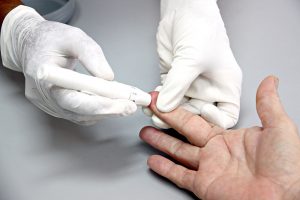In today’s fast-paced corporate environment, the health and well-being of employees have never been more critical. As organizations strive to enhance productivity and foster a positive workplace culture, corporate wellness programs have emerged as a vital tool for promoting employee health.
With a strong monetary ROI, general reduction in absenteeism, and overall favorable views from employees, corporate wellness programs are the new norm for businesses everywhere.
However, with a myriad of options available, choosing the right program can feel overwhelming. Here, we’ll explore a few benefits of these programs, as well as a big choice you’ll need to make as part of your program when it comes to blood work: Should you opt for convenience, or thoroughness?
By investing in the right wellness initiative, you can create a healthier, happier workforce that ultimately drives your organization’s success.
Let’s break it down.
RELATED ARTICLE: The Benefits of Mobile Medical Testing
RELATED ARTICLE: Discover the Benefits of Onsite Respirator- Fit Testing and Audiometric Exams with Worksite Medical
Corporate Wellness Testing
So, you decided to add a corporate wellness program to your business. That’s great, and you’re certainly not alone.
In the US, approximately 85% of large and 54% of small companies offer one or more wellness programs, in order to reduce chronic diseases such as diabetes and obesity. Many employees make their programs incentive-based.
In some cases, they offer bonuses for things like reducing cholesterol and quitting smoking.
Chronic diseases account for about 86% of national health care costs, mostly because they affect nearly half of all American adults.
Wellness programs monitor employee health in several ways. They include glucose levels checks to screen for diabetes; cholesterol examinations; and blood pressure readings.
It’s estimated that companies earn an ROI of $1.50 for every dollar spent on wellness.
That means cutting corners on certain aspects, such as blood testing, might actually cost employers in the long-run.
Biometric Screening: Finger-stick or Blood Draw?
There are two common types of biometric screening blood draws that health professionals use for corporate wellness testing: Venipuncture and capillary, AKA finger-stick.
With venipuncture, blood samples are collected from veins, and then sent to a lab for testing.
The results take longer to receive (typically 1-3 days), and they require the patient to fast for about 12 hours. The capillary blood draw is considered as a non-invasive, quick, and inexpensive alternative to venipuncture.
It offers immediate reads on cholesterol and glucose levels, all through a simple prick of a finger.
Sounds great, right? Quick and relatively painless testing with instant results? Sign me up!
Well, not so fast.
In this consumer-driven world where people purchase Amazon Prime accounts for next-day delivery, immediacy is king. So, when a comparable service offered at a lesser rate yields instant results, it’s a no-brainer, right?
Not necessarily, as biometric screening stands as the wellness benchmark.
It provides ROI metrics by answering questions, such as: “Are my employees achieving their goals?”, and “Is our money being put to good use?”
As a business professional, you need to obtain accurate results to support your bottom line.
Making the right, most cost-effective choice in biometric screening contributes to the success of your program, and reduces future costs.
Finger-stick Blood Test Less Accurate
As convenient as the finger-stick method may sound, it generally provides less accurate results than a traditional venipuncture.
“Finger-sticking is good to give you a quick snapshot,” said one Worksite Medical physician. “The venipuncture is a more thorough representation of how a patient is doing because it provides an acute analysis of current diabetic and metabolic status.”
“Finger-sticking has its place, but it’s not as accurate. It lets you know that there could potentially be a problem, but it should never replace fasting blood work.”
Running a profitable company and blindly spending money don’t mix. Finger-sticking isn’t necessarily blind spending, but it does come with a few blind spots.
Let’s take, for example, cholesterol. Your body requires that waxy, fat-like substance in order to properly digest food.
However, when cholesterol levels are too high, the risk for coronary heart disease (CHD) increases drastically.
That proves as significant because Coronary heart disease (CHD) is the most common type of heart disease in the U.S, killing about 371,506 people in 2022.
Get the Most information with Venipuncture
According to the National Center for Chronic Disease Prevention and Health Promotion (CDC), chronic diseases already drive employer health care costs sky-high.
Now, imagine rewarding an employee for lowering his/her cholesterol, only to pay that same employee’s heart disease health care costs a few months later.
It’s a lose-lose situation.
Venipuncture blood testing covers specific aspects of cholesterol with a lipid profile.
The finger-stick uses total cholesterol count, which only offers generalized heart disease risk information.
A potentially deadly disease screening should be thorough, not approximate. Also, employers who offer incentive-driven programs shouldn’t be paying for incomplete blood test results.
What’s more is that venipuncture provides the highest amount of health information by way of a chemistry 25 profile and complete blood count (CBC).
Lab results from a chemistry profile show kidney function, potassium levels, sodium levels, and protein.
The CBC evaluates overall health and detects disorders, such as infections, anemia, and leukemia.
For the most part, a capillary test only covers cholesterol and glucose levels.
And, if the technician finds irregularities, the employee will inevitably need the entire lab evaluation anyways, meaning you’ll end up paying for a venipuncture test, too.
At the point, the cost outweighs the initial benefits of immediacy and low price.
Make sure that you’re getting the most out of your corporate wellness program, and choose the right testing.
To get a free quote on, or schedule, a mobile corporate wellness event for your workplace, complete the form below or call us at 1-844-622-8633.
Key Takeaways
Selecting the right corporate wellness program is a significant step toward cultivating a thriving workplace. By understanding your employees’ unique needs, evaluating various program options, and considering the long-term benefits, you can make an informed decision that enhances both individual well-being and organizational performance.
Remember, a successful wellness program is not just about the activities offered; it’s about creating a culture of health that empowers employees to take charge of their well-being.
As you embark on this journey, keep in mind that the right program can lead to increased morale, reduced absenteeism, and a more engaged workforce, paving the way for a brighter, healthier future for everyone involved.
Stay In Compliance With Worksite Medical
In most cases, OSHA requires medical surveillance testing, and at no cost to employees.
Worksite Medical makes that program easier with mobile medical testing.
With Worksite Medical, you get all the resources of a lab brought directly to your worksite, minimizing your workers’ downtime.
We’ll tailor a comprehensive medical surveillance program to your specific needs. Our services include silica exams, physical testing, heavy metal labs, PPE fit testing, x-rays, audiometric exams, drug & alcohol screenings, assistance with corporate wellness programs, and much more. We safely maintain all of your team’s medical records, and provide you with quick access.
You’ll keep your employees at work, and stay ahead of OSHA inspections.
Protect your team and your workplace now with Worksite Medical. Not sure what you need? Try our medical testing wizard here.

Create a Less Disruptive, More Productive Occupational Health Plan with Worksite Medical!
Are you looking for a way to keep your team safe, while also limiting risk and increasing production? Simplify your medical plan today. We help team leaders like you develop less disruptive, more convenient occupational health plans that comply with complex industry standards, thus creating a healthier, more productive workforce. Take control of your medical testing program.




